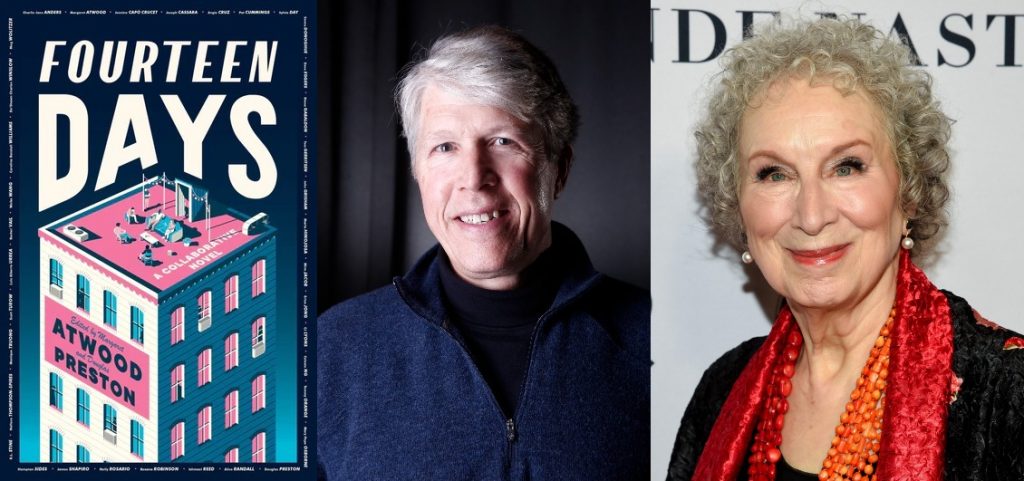The pandemic isolated people like never before.
But the pandemic novel “Fourteen Days” has brought together a specific group of people – successful authors – like never before.
The novel is set largely on the roof of a shabby Manhattan apartment building, where a group of strangers gather each night for a breath of fresh air. Gradually, they start sharing stories from their lives – each one penned by a different author, three dozen in all, including Charlie Jane Anders, Maria Hinojosa, Dave Eggers, John Grisham, Celeste Ng, Tommy Orange, R.L. Stine, Scott Turow, Luis Alberto Urrea and Meg Wolitzer as well as Margaret Atwood, who served as the editor alongside Douglas Preston.
The proceeds go to the Author’s Guild Foundation.
“This will finance our fight against book banning and against the big AI companies that are ingesting hundreds of thousands of our books to build AI systems,” Preston said in a recent video interview. “We’re litigating against book banning or providing legal assistance and we’re winning. We’re also suing the AI companies that have stolen our books. There’s a class action lawsuit against OpenAI and Microsoft for ingesting 200,000 books to build ChatGPT. It’s not fair use. They’re building a very valuable commercial product.”
Some of the funds, he added, including a “very generous grant” from James Patterson, will also build a licensing system so authors can sign up to have their books ingested and licensed to those companies who will pay fairly for the use of their work.
This interview has been edited for length and clarity.
Q How did this come about?
About 30 or 40 years ago, I started a pandemic novel patterned after “The Decameron.” [Giovanni Boccaccio’s 14th-century book about a group of people who tell each other stories as they hide out from the Black Plague.] I had a bunch of rich people going off to some estate on the main coast, and it was just terrible so I gave it up.
Then the pandemic hit for real and I was president of the Author’s Guild so I proposed this idea about a novel for the people who couldn’t leave New York and go to the Hamptons or Cape Cod or wherever, the left-behinds.
Q Where were you during the pandemic?
I was in New York until March 14th when they shut down the city. That was pretty terrifying. And then I was one of the people who fled. I went to Maine.
Q How did you go collecting all these authors?
Margaret Atwood is a great friend of the Authors Guild, and she recruited the authors; she’s such a towering literary figure that everyone responded.
We hope the book will allow readers to discover new authors. I had never read a book by Celeste Ng but after reading her story I rushed out and bought “Little Fires Everywhere” and it’s one of the best novels I’ve ever read. So we’re hoping that the reader will approach this in the mode of discovery.
Q What was each author’s assignment?
We didn’t give any directions except to say the story has to be told in the first person. It didn’t have to be a certain length. We didn’t even tell them too much about the project.
Q Then you wrote a framework to scaffold the stories?
First, I put the stories in some kind of order so that there’s an arc and characters could react to each story – one story might suggest another one from a different character, like a chain reaction.
But then there has to be a frame, a single person who is telling the story in which all the other stories are embedded, sort of like 1,001 nights. So I had to create the character of Yessenia, the new building superintendent who doesn’t like the building and is suspicious of the tenants.
Then I had to come up with fictional characters to tell these stories and they had to be consistent with the voice and the background of the person speaking. I’d create a character like Vinegar (a salty older woman) and then look at the stories to see which ones match her voice. Or I’d say, let me create a character to fit Celeste Ng’s story – that one is told with a sophistication and great vocabulary so I made her a therapist. Then I looked around and said, ‘What other stories could be told by a therapist?’ One was by Tess Gerritsen, who’s actually a medical doctor.
Q The book is about the toll of the pandemic but also about how we use stories to evaluate and organize and think about our lives.
I studied anthropology and worked at the Museum of Natural History so I tend to take an anthropological view and stories tell us who we are. They’re how we transmit culture and our values from one generation to the next.
Related Articles
Disneyland closes 4 attractions during busy festival season
Horoscopes Feb. 26, 2024: Michael Bolton, own the spotlight
Photos: 7th annual Black Joy Parade kicks off in downtown Oakland
Review: U2 finishing up epic Sphere Las Vegas run in legendary fashion
Photos: San Francisco’s Lunar New Year parade celebrates the Year of the Dragon
In every human culture on earth, storytelling is a central part. It’s embedded in our very genes. We tell stories to make sense of tragedy, of war, of violence, of pandemics. We tell stories to make sense of a terrifying and senseless world. And that’s what this book is really about.
These characters are not telling stories about the pandemic, they’re telling about their lives and it’s a comfort to them. And through this process, they become a community. Storytelling is a profound part of building community. That’s what this book is really about.


